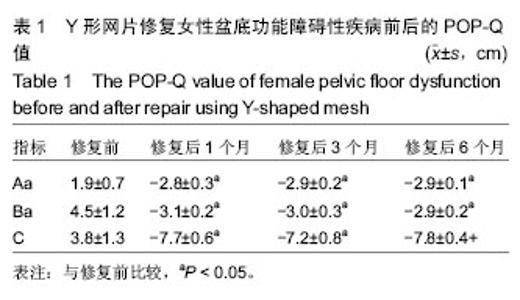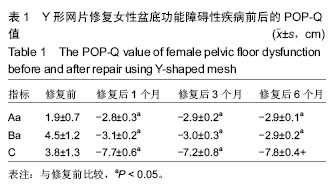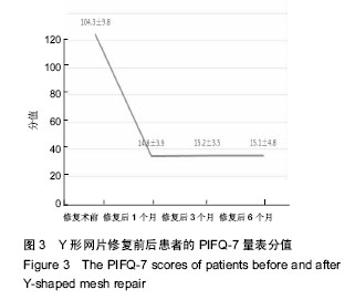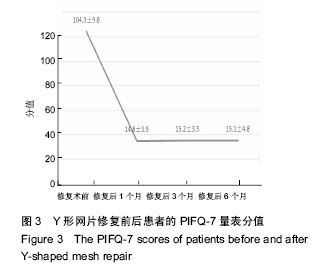Chinese Journal of Tissue Engineering Research ›› 2016, Vol. 20 ›› Issue (30): 4503-4508.doi: 10.3969/j.issn.2095-4344.2016.30.014
Previous Articles Next Articles
Use of the Y-shaped mesh in functional repair of the pelvic floor in women
Zhang Yu-di, Lu Dan, Zheng Ping, Wu Xia, Li Hui, Liu Ju-hong
- Beijing Obstetrics and Gynecology Hospital, Capital Medical University, Beijing 100026, China
-
Received:2016-05-08Online:2016-07-15Published:2016-07-15 -
Contact:Lu Dan, Chief physician, Beijing Obstetrics and Gynecology Hospital, Capital Medical University, Beijing 100026, China -
About author:Zhang Yu-di, Master, Associate chief physician, Beijing Obstetrics and Gynecology Hospital, Capital Medical University, Beijing 100026, China
CLC Number:
Cite this article
Zhang Yu-di, Lu Dan, Zheng Ping, Wu Xia, Li Hui, Liu Ju-hong. Use of the Y-shaped mesh in functional repair of the pelvic floor in women[J]. Chinese Journal of Tissue Engineering Research, 2016, 20(30): 4503-4508.
share this article

2.1 参与者数量分析 10例患者均顺利完成至少半年以上随访,进入结果分析。 2.2 围手术期指标 所有手术均顺利完成,术后愈合良好,无盆腔感染、神经损伤及术后并发症发生,手术时间120-220 min,平均(176.00±32.04) min;术中出血量为20-200 mL,平均(61.00±62.08) mL;住院 6-14 d,平均(9.5±2.8) d;尿管留置时间为1-3 d,平均(1.5±0.6) d;修复后的疼痛评分明显低于修复前(3.5± 0.8,2.4±1.8,P < 0.05)。 2.3 修复前后POP-Q值 与修复前相比,修复后1,3,6个月Aa、Ba及C值均显著改善(P < 0.05),上述各指标修复后不同时间点比较差异无显著性意义(P > 0.05),见表1。从体检的重要的标志点POP-Q值可见,手术有效改善患者的盆底功能,说明采用生物网片修复具有良好的解剖重建效果。"


2.4 修复前后PFIQ-7量表数据 修复前分值为(104.3±9.8) 分,修复后1,3,6个月分别为(14.8±3.9),(15.2±3.5),(15.1±4.8)分。与修复前相比,修复后不同时间点时间点PFIQ-7量表分值显著改善(P < 0.05),其趋势图详见图3。可见经过治疗,患者的生活质量明显改善并能有效保持。 2.5 不良反应 所有患者均完成半年以上随访,恢复至正常性生活,未有不适主诉。在随访期内有1例术后1个月阴道残端感染,经过阴道上药后好转,术后3个月复查无不适主述,阴道残端愈合好。在随访期内无网片侵蚀、等材料相关并发症发生,阴道弹性好,柔软度好,性生活满意,总体治疗满意。"

| [1] Meldrum DR,Burnett AL,Dorey G,et al.Erectile hydraulics: maximizing inflow while minimizing outflow. J Sex Med. 2014;11(5):1208-1220.
[2] Yu SW,Rao SS.Anorectal physiology and pathophysiology in the elderly.Clin Geriatr Med. 2014; 30(1):95-106.
[3] Moldwin RM,Fariello JY.Myofascial trigger points of the pelvic floor: associations with urological pain syndromes and treatment strategies including injection therapy.Curr Urol Rep. 2013;14(5):409-417.
[4] Hong L,Li HF,Sun J,et al.Clinical observation of a modified surgical method: posterior vaginal mesh suspension of female rectocele with intractable constipation.J Minim Invasive Gynecol. 2012;19(6): 684-688.
[5] Mohammed N,Raschid Hoda M,Fornara P.Prolapse surgery in octogenarians: are we pushing the limits too far?World J Urol.2013;31(3):623-628.
[6] Dällenbach P.To mesh or not to mesh: a review of pelvic organ reconstructive surgery.Int J Womens Health.2015;7:331-343.
[7] Feldmann TF,Young MT,Pigazzi A.Incisional reinforcement in high-risk patients.Clin Colon Rectal Surg.2014;27(4):149-155.
[8] Wood LN, Anger JT.Urinary incontinence in women. BMJ. 2014;349:g4531.
[9] Musters GD,Buskens CJ,Bemelman WA,et al.Perineal wound healing after abdominoperineal resection for rectal cancer: a systematic review and meta-analysis. Dis Colon Rectum. 2014;57(9):1129-1139.
[10] Colaco M,Mettu J,Badlani G.The scientific basis for the use of biomaterials in stress urinary incontinence (SUI) and pelvic organ prolapse (POP).BJU Int. 2015;115(6): 859-866.
[11] Alvarez J,Cvach K,Dwyer P.Complications in pelvic floor surgery.Minerva Ginecol. 2013;65(1):53-67.
[12] Ahmad M,Sileri P,Franceschilli L,et al.The role of biologics in pelvic floor surgery.Colorectal Dis.2012;14 Suppl 3:19-23.
[13] Schey R,Cromwell J,Rao SS.Medical and surgical management of pelvic floor disorders affecting defecation. Am J Gastroenterol. 2012;107(11): 1624-1633.
[14] Abed H,Rahn DD,Lowenstein L,et al.Incidence and management of graft erosion, wound granulation, and dyspareunia following vaginal prolapse repair with graft materials: a systematic review.Int Urogynecol J.2011; 22(7):789-798.
[15] Haylen BT,Freeman RM,Swift SE,et al.An International Urogynecological Association (IUGA)/International Continence Society (ICS) joint terminology and classification of the complications related directly to the insertion of prostheses (meshes, implants, tapes) and grafts in female pelvic floor surgery.Neurourol Urodyn. 2011;30(1):2-12.
[16] Wagenlehner FM,Gunnemann A,Liedl B,et al. Functional aspects of pelvic floor surgery.Aktuelle Urol.2009;40(6):345-50.
[17] Baessler K.Do we need meshes in pelvic floor reconstruction?World J Urol. 2012;30(4):479-486.
[18] Toh VV,Bogne V,Bako A.Management of recurrent vault prolapse.Int Urogynecol J.2012;23(1):29-34.
[19] de Tayrac R,Letouzey V.Basic science and clinical aspects of mesh infection in pelvic floor reconstructive surgery.Int Urogynecol J.2011;22(7):775-780.
[20] Ashok K, Petri E.Failures and complications in pelvic floor surgery.World J Urol. 2012;30(4):487-794.
[21] Umoh UE,Arya LA.Surgery in urogynecology.Minerva Med.2012;103(1):23-36.
[22] Fleischer AC,Harvey SM,Kurita SC,et al.Two-/three- dimensional transperineal sonography of complicated tape and mesh implants.Ultrasound Q. 2012;28(4): 243-249.
[23] van Geelen JM,Dwyer PL.Where to for pelvic organ prolapse treatment after the FDA pronouncements? A systematic review of the recent literature.Int Urogynecol J.2013;24(5):707-718.
[24] Ga?czyński K,Futyma K,Bar K,et al.Bladder injury during sling operation in the treatment of SUI--review of literature and case report.Ginekol Pol.2012; 83(10): 784-788.
[25] Nosti PA,Iglesia CB.Medicolegal issues surrounding devices and mesh for surgical treatment of prolapse and incontinence.Clin Obstet Gynecol. 2013;56(2): 221-228.
[26] Park JH,Velu LK,Dayal SP,et al.Sacral osteomyelitis following restorative rectal cancer resection: a delayed presentation of dormant pelvic sepsis.Scott Med J. 2013;58(1):e20-23.
[27] Kow N,Goldman HB,Ridgeway B.Management options for women with uterine prolapse interested in uterine preservation.Curr Urol Rep. 013;14(5):395-402.
[28] Naumann G,Kölbl H.Current developments and perspectives on the diagnosis and treatment of urinary incontinence and genital prolapse in women.Aktuelle Urol. 2013;44(3):201-206.
[29] Chen B,Dave B.Challenges and future prospects for tissue engineering in female pelvic medicine and reconstructive surgery.Curr Urol Rep.2014;15(8):425.
[30] Dällenbach P.To mesh or not to mesh: a review of pelvic organ reconstructive surgery.Int J Womens Health.2015;7:331-343.
[31] Alas AN,Anger JT.Management of apical pelvic organ prolapse.Curr Urol Rep. 2015;16(5):33.
[32] Rickert A,Kienle P.Laparoscopic surgery for rectal prolapse and pelvic floor disorders.World J Gastrointest Endosc.2015;7(12):1045-1054.
[33] Halwani Y,Nicolau-Toulouse V,Oakes J,et al. Transvaginal strangulated small intestinal hernia after abdominal sacrocolpopexy: case report and literature review.Hernia.2013;17(2):279-283.
[34] Santen RJ.Vaginal administration of estradiol: effects of dose, preparation and timing on plasma estradiol levels.Climacteric.2015;18(2):121-134.
[35] Given FT Jr,Muhlendorf IK,Browning GM.Vaginal length and sexual function after colpopexy for complete uterovaginal eversion.Am J Obstet Gynecol. 1993;169(2 Pt 1):284-287.
[36] Scarpero HM,Cespedes RD,Winters JC. Transabdominal approach to repair of vaginal vault prolapse.Tech Urol.2001;7(2):139-145.
[37] Mendivil AA,Rettenmaier MA,Abaid LN,et al.Survival rate comparisons amongst cervical cancer patients treated with an open, robotic-assisted or laparoscopic radical hysterectomy: A five year experience.Surg Oncol.2015.pii: S0960-7404(15)30026-8.
[38] Llarena NC,Shah AB,Milad MP.Bowel injury in gynecologic laparoscopy: a systematic review.Obstet Gynecol.2015;125(6):1407-1417.
[39] Graziano A,Lo Monte G,Piva I,et al.Diagnostic findings in adenomyosis: a pictorial review on the major concerns.Eur Rev Med Pharmacol Sci. 2015;19(7): 1146-1154.
[40] Roach MK,Thomassee MS.Acquired Uterine Arteriovenous Malformation and Retained Placenta Increta.Obstet Gynecol.2015;126(3):642-644. |
| [1] | Zhang Tongtong, Wang Zhonghua, Wen Jie, Song Yuxin, Liu Lin. Application of three-dimensional printing model in surgical resection and reconstruction of cervical tumor [J]. Chinese Journal of Tissue Engineering Research, 2021, 25(9): 1335-1339. |
| [2] | Zeng Yanhua, Hao Yanlei. In vitro culture and purification of Schwann cells: a systematic review [J]. Chinese Journal of Tissue Engineering Research, 2021, 25(7): 1135-1141. |
| [3] | Xu Dongzi, Zhang Ting, Ouyang Zhaolian. The global competitive situation of cardiac tissue engineering based on patent analysis [J]. Chinese Journal of Tissue Engineering Research, 2021, 25(5): 807-812. |
| [4] | Wu Zijian, Hu Zhaoduan, Xie Youqiong, Wang Feng, Li Jia, Li Bocun, Cai Guowei, Peng Rui. Three-dimensional printing technology and bone tissue engineering research: literature metrology and visual analysis of research hotspots [J]. Chinese Journal of Tissue Engineering Research, 2021, 25(4): 564-569. |
| [5] | Chang Wenliao, Zhao Jie, Sun Xiaoliang, Wang Kun, Wu Guofeng, Zhou Jian, Li Shuxiang, Sun Han. Material selection, theoretical design and biomimetic function of artificial periosteum [J]. Chinese Journal of Tissue Engineering Research, 2021, 25(4): 600-606. |
| [6] | Liu Fei, Cui Yutao, Liu He. Advantages and problems of local antibiotic delivery system in the treatment of osteomyelitis [J]. Chinese Journal of Tissue Engineering Research, 2021, 25(4): 614-620. |
| [7] | Li Xiaozhuang, Duan Hao, Wang Weizhou, Tang Zhihong, Wang Yanghao, He Fei. Application of bone tissue engineering materials in the treatment of bone defect diseases in vivo [J]. Chinese Journal of Tissue Engineering Research, 2021, 25(4): 626-631. |
| [8] | Zhang Zhenkun, Li Zhe, Li Ya, Wang Yingying, Wang Yaping, Zhou Xinkui, Ma Shanshan, Guan Fangxia. Application of alginate based hydrogels/dressings in wound healing: sustained, dynamic and sequential release [J]. Chinese Journal of Tissue Engineering Research, 2021, 25(4): 638-643. |
| [9] | Chen Jiana, Qiu Yanling, Nie Minhai, Liu Xuqian. Tissue engineering scaffolds in repairing oral and maxillofacial soft tissue defects [J]. Chinese Journal of Tissue Engineering Research, 2021, 25(4): 644-650. |
| [10] | Xing Hao, Zhang Yonghong, Wang Dong. Advantages and disadvantages of repairing large-segment bone defect [J]. Chinese Journal of Tissue Engineering Research, 2021, 25(3): 426-430. |
| [11] | Chen Siqi, Xian Debin, Xu Rongsheng, Qin Zhongjie, Zhang Lei, Xia Delin. Effects of bone marrow mesenchymal stem cells and human umbilical vein endothelial cells combined with hydroxyapatite-tricalcium phosphate scaffolds on early angiogenesis in skull defect repair in rats [J]. Chinese Journal of Tissue Engineering Research, 2021, 25(22): 3458-3465. |
| [12] | Wang Hao, Chen Mingxue, Li Junkang, Luo Xujiang, Peng Liqing, Li Huo, Huang Bo, Tian Guangzhao, Liu Shuyun, Sui Xiang, Huang Jingxiang, Guo Quanyi, Lu Xiaobo. Decellularized porcine skin matrix for tissue-engineered meniscus scaffold [J]. Chinese Journal of Tissue Engineering Research, 2021, 25(22): 3473-3478. |
| [13] | Mo Jianling, He Shaoru, Feng Bowen, Jian Minqiao, Zhang Xiaohui, Liu Caisheng, Liang Yijing, Liu Yumei, Chen Liang, Zhou Haiyu, Liu Yanhui. Forming prevascularized cell sheets and the expression of angiogenesis-related factors [J]. Chinese Journal of Tissue Engineering Research, 2021, 25(22): 3479-3486. |
| [14] | Liu Chang, Li Datong, Liu Yuan, Kong Lingbo, Guo Rui, Yang Lixue, Hao Dingjun, He Baorong. Poor efficacy after vertebral augmentation surgery of acute symptomatic thoracolumbar osteoporotic compression fracture: relationship with bone cement, bone mineral density, and adjacent fractures [J]. Chinese Journal of Tissue Engineering Research, 2021, 25(22): 3510-3516. |
| [15] | Liu Liyong, Zhou Lei. Research and development status and development trend of hydrogel in tissue engineering based on patent information [J]. Chinese Journal of Tissue Engineering Research, 2021, 25(22): 3527-3533. |
| Viewed | ||||||
|
Full text |
|
|||||
|
Abstract |
|
|||||